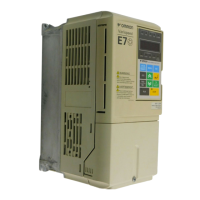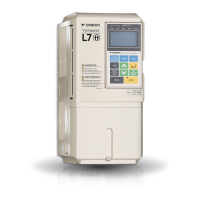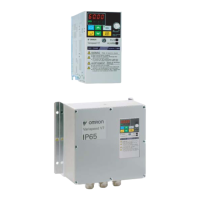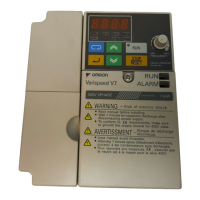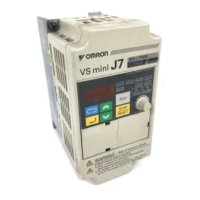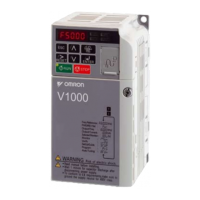4-14
4
Adjustment Suggestions
If hunting, vibration, or other problems originated in the control system occur during trial operation, adjust the
parameters listed in the following table according to the control method. This table lists the most commonly
used parameters only.
Table 4.4 Adjusted Parameters
Control
Method
Name (Parameter
Number)
Influence
Factory
Setting
Recom-
mended
Setting
Adjustment Method
V/f control
(A1-02 = 0
or 1)
Hunting-prevention
gain (n1-02)
Controlling hunting
and vibration in mid-
dle-range speeds (10 to
40 Hz)
1.00 0.50 to 2.00
• Reduce the setting if
torque is insufficient for
heavy loads.
• Increase the setting if hunt-
ing or vibration occurs for
light loads.
Carrier frequency
selection
(C6-02)
• Reducing motor
magnetic noise
• Controlling hunting
and vibration at low
speeds
Depends
on capac-
ity
0 to default
• Increase the setting if
motor magnetic noise is
high.
• Reduce the setting if hunt-
ing or vibration occurs at
low to middle-range
speeds.
Torque compensation
primary delay time
constant (C4-02)
• Increasing torque
and speed response
• Controlling hunting
and vibration
Depends
on capac-
ity
200 to 1000
ms
• Reduce the setting if
torque or speed response is
low.
• Increase the setting if hunt-
ing or vibration occurs.
Torque compensation
gain (C4-01)
• Improving torque at
low speeds (10 Hz
or lower)
• Controlling hunting
and vibration
1.00 0.50 to 1.50
• Increase the setting if
torque is insufficient at
low speeds.
• Reduce the setting if hunt-
ing or vibration occurs for
light loads.
Middle output fre-
quency voltage
(E1-08)
Minimum output fre-
quency voltage
(E1-10)
• Improving torque at
low speeds
• Controlling shock at
startup
Depends
on capac-
ity and
voltage
Default to
Default +
5V
*
• Increase the setting if
torque is insufficient at
low speeds.
• Reduce the setting if the
shock at startup is large.
Open Loop
Vector con-
trol
(A1-02 = 2)
Speed feedback detec-
tion control (AFR)
gain
(n2-01)
• Increasing torque
and speed response
• Controlling hunting
and vibration in mid-
dle-range speeds (10
to 40 Hz)
1.00 0.50 to 2.00
• Reduce the setting if
torque or speed response is
low.
• Increase the setting if hunt-
ing or vibration occurs.
Torque compensation
primary delay time
constant (C4-02)
• Increasing torque
and speed response
• Controlling hunting
and vibration
20 ms 20 to 200 ms
• Reduce the setting if
torque or speed response is
low.
• Increase the setting if hunt-
ing or vibration occurs.
Slip compensation pri-
mary delay time
(C3-02)
• Increasing speed
response
• Improving speed sta-
bility
200 ms
100 to
500 ms
• Reduce the setting if speed
response is low.
• Increase the setting if the
speed is not stable.
Slip compensation
gain (C3-01)
• Improving speed
accuracy
1.0 0.5 to 1.5
• Increase the setting if
speed response is low.
• Reduce the setting if the
speed is too high.
